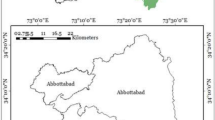Abstract
Land-cover classification can construct a land-use map to analyze satellite images using machine learning. However, supervised machine learning requires a lot of training data since remote sensing data is of higher resolution that reveals many features. Therefore, this study proposed a method to generate self-training data from a small amount of training data. This method generates self-training, which is regarded as the correct class to consider various times and the surrounding land cover. As a result of self-training conducted using this method, the Kappa coefficient was 0.644 for 12 classification problems with one training data per class.
Access this chapter
Tax calculation will be finalised at checkout
Purchases are for personal use only
Similar content being viewed by others
References
Hansen, M., Loveland, T.: A review of large area monitoring of land cover change using Landsat data. Remote Sens. Environ. 122, 66–74 (2012)
Zhu, Z., Woodcock, C.: Continuous change detection and classification of land cover using all available Landsat data. Remote Sens. Environ. 114, 152–171 (2014)
Lu, D., Weng, Q.: A survey of image classification methods and techniques for improving classification performance. Int. J. Remote Sens. 28(5), 823–870 (2007)
Strahler, A.: The use of prior probabilities in maximum likelihood classification of remotely sensed data. Remote Sens. Environ. 10, 135–163 (1980)
Rodriguez-Galiano, V., Ghimire, B., Rogan, J., et al.: An assessment of the effectiveness of a random forest classifier for land cover classification. ISPRS J. Photogrammetry Remote Sens. 67, 93–104 (2012)
Pal, M., Mather, P.M.: Support vector machines for classification in remote sensing. Int. J. Remote Sens. 26(5), 1007–1011 (2005)
Banerjee, B., Bovolo, F., Bhattacharya, A., et al.: A new self-training based unsupervised satellite image classification technique using cluster ensemble strategy. Geosc. Remote Sens. Lett. 12(4), 741–745 (2015)
Canty, M.: Image Analysis, Classification and Change Detection in Remote Sensing with Algorithms for ENVI/IDL. CRC Press, Boca Raton (2007)
Dube, T., Mutanga, O.: Evaluating the utility of the medium-spatial resolution Landsat 8 multispectral sensor in quantifying aboveground biomass in uMgeni catchment, South Africa. ISPRS J. Photogrammetry Remote Sens. 101, 36–46 (2015)
Congalton, R.: A review of assessing the accuracy of classifications of remotely sensed data. Remote Sens. Environ. 37, 35–46 (1991)
Landis, J., Koch, G.: The measurement of observer agreement for categorical data. Biometrics 33, 159–174 (1977)
Kamagata, N., Hara, K.: Vegetation mapping by object-based image analysis, evaluation of classification accuracy and boundary extraction in a mountainous region of central Honshu, Japan. Veg. Sci. 27, 83–94 (2010)
Author information
Authors and Affiliations
Corresponding author
Editor information
Editors and Affiliations
Rights and permissions
Copyright information
© 2016 Springer-Verlag Berlin Heidelberg
About this paper
Cite this paper
Oya, Y., Kanamori, K., Ohwada, H. (2016). Recursive Ensemble Land Cover Classification with Little Training Data and Many Classes. In: Nguyen, N.T., Trawiński, B., Fujita, H., Hong, TP. (eds) Intelligent Information and Database Systems. ACIIDS 2016. Lecture Notes in Computer Science(), vol 9621. Springer, Berlin, Heidelberg. https://doi.org/10.1007/978-3-662-49381-6_50
Download citation
DOI: https://doi.org/10.1007/978-3-662-49381-6_50
Publisher Name: Springer, Berlin, Heidelberg
Print ISBN: 978-3-662-49380-9
Online ISBN: 978-3-662-49381-6
eBook Packages: Computer ScienceComputer Science (R0)




